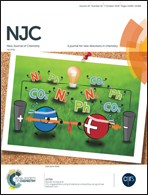Gold nanorod-based fluorometric ELISA for the sensitive detection of a cancer biomarker†
Abstract
The combinatorial use of an enzyme-linked immunosorbent assay (ELISA) and nanoparticles (i.e. nanoELISA) facilitates the improved detection of biomarkers. In the present study, we have developed a gold nanorod-based fluorometric immunoassay (nanoELIFA) for the non-invasive detection of CA125 (an ovarian cancer biomarker) using a fluorogenic substrate, 3-p-hydroxyphenylpropionic acid (HPPA). NanoELIFA showed improved sensitivity (detection limit 0.066 U mL−1) over classical ELIFA (detection limit: 0.23 U mL−1) due to the integration of gold nanorods, which act as a signal enhancer with an additional advantage of fluorescence-based detection for improved sensitivity. The sensitivity of the analyses was tested in the range of 0–400 U mL−1. Furthermore, the reproducibility and selectivity of nanoELIFA were analyzed and indicative of the good performance of the system. This method was initially tested using spiked simulated blood plasma and cell culture media, and finally, was analyzed in plasma (as such and spiked) and supernatant media from in vitro cell samples. The good recovery percentages indicated in all these cases highlighted the applicability of the developed nanoELIFA for real sample analysis.



 Please wait while we load your content...
Please wait while we load your content...